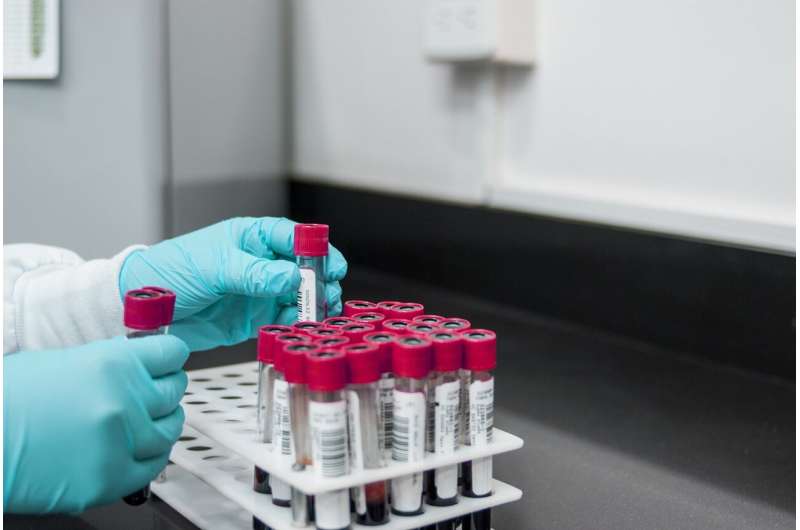This article has been reviewed according to Science X's editorial process and policies. Editors have highlighted the following attributes while ensuring the content's credibility:
fact-checked
peer-reviewed publication
trusted source
proofread
New research highlights combining prostate MRI with a blood test to avoid unnecessary prostate biopsies

MRI of the prostate, combined with a blood test, can help determine if a prostate lesion is clinically significant cancer, new research suggests
A new meta-analysis by investigators from Brigham and Women's Hospital suggests that doctors and patients can avoid unnecessary prostate biopsies by combining MRI of the prostate findings with prostate-specific antigen (PSA) density.
This new approach to diagnosing clinically significant prostate cancer can decrease patient harm and health care costs of prostate biopsies. Their results are published in JAMA Network Open.
An enlarged prostate or potential prostate cancer is a common issue for older men. There will be approximately 300,000 new cases of prostate cancer in the U.S. this year. But not all those cancers require treatment—or even need to be biopsied.
"In the workup of men suspected of having prostate cancer, prostate MRI findings combined with PSA density measurement can help doctors decide which patients to biopsy," said senior author Ramin Khorasani, MD, MPH, Radiology Vice Chair for Quality and Safety at Brigham and Women's Hospital and Mass General Brigham and Philip H. Cook Professor of Radiology at Harvard Medical School.
"With this new analysis, we looked to see how MRI can help urologists decide which patients to biopsy and which patients may not need aggressive diagnosis and treatment."
Researchers have known for a long time that not all prostate cancer is dangerous. However, telling which cancers need treatment without a biopsy can be difficult. Biopsies, especially those of the prostate, can be uncomfortable, invasive, and expensive.
To doctors, clinically significant prostate cancer (csPCa) is prostate cancer that has a high chance of threatening a patient's life. They have cells that look more aggressive, or cancer is found outside of the prostate gland.
"Prostate cancer is the second most common cancer in men worldwide, but we need to be able to identify patients who require prostate biopsy while avoiding unnecessary procedures and minimizing the risk of missing clinically significant prostate cancer," Adam Kibel, MD, chair of the Department of Urology and co-author of the study.
"These findings suggest that patient-tailored prostate biopsy decisions based on information from MRI and blood tests could prevent unnecessary procedures while maintaining high sensitivity."
MRI of the prostate can provide some of this information. Still, a biopsy is traditionally needed to determine how aggressive the cancer cells look. This study tested a new approach: combining MRI-based prostate imaging reporting and data system (PI-RADS) scores with prostate-specific antigen (PSA) density to determine which cancers were likely to be clinically significant without including information from a biopsy.
PI-RADS scores the prostate lesion from 1 (highly unlikely to be clinically significant) to 5 (cancer is highly likely to be clinically significant). PSA density (PSAD) is the PSA blood level divided by the prostate's volume (as determined by MRI).
The JAMA Network Open study builds upon previous findings from a similar study using data only obtained at Brigham Women's Hospital, published in the Journal of the American College of Radiology in 2022. That study found that an analysis using PI-RADS and PSAD cutoffs could pinpoint up to 50% of cases in which a biopsy would be unnecessary.
The new study, whose first and second authors are Arya Haj-Mirzaian, MD, MPH, and Kristine S. Burk, MD, did the same analysis on data from 72 previously published studies of men with prostate cancer, including their PI-RADS results, prostate-specific antigen density testing, and determination of clinical significance from a biopsy.
The meta-analysis gave them a dataset of more than 36,000 patients to determine if their earlier findings at BWH held in a more diverse sample set. They found that prostate biopsies may be unnecessary for patients with a PI-RADS under 4 and a PSAD below 0.10 ng/ml2. The researchers found that using specific PI-RADS and PSAD cutoffs, doctors could confidently skip 50% of biopsies while only missing 5% of clinically significant cancers, or they could skip 30% and only miss 3%.
"These data give us the confidence to say that in some cases, we can safely follow men with testing rather than aggressively pursue a biopsy in all cases," Kibel said. "By making this information available to physicians and patients, we can help them make a more informed decision about undergoing a biopsy."
The next step in this research is using the analysis to create an easy-to-use patient-level scoring system that urologists can use to evaluate their patient's need for a biopsy.
More information: Haj-Mirzaian, A et al. Magnetic Resonance Imaging, Clinical, and Biopsy Findings in Suspected Prostate Cancer: A Systematic Review and Meta-Analysis, JAMA Network Open (2024). DOI: 10.1001/jamanetworkopen.2024.4258

















